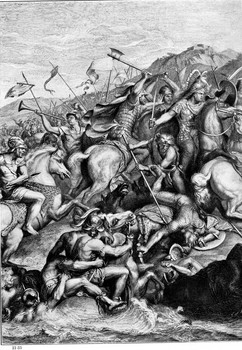The Life and Successes of Alexander the Great
Part 2: Revenge for Past Sufferings So the Macedonians and Greek set off, crossing the Hellespont and reversing the great crossing that Xerxes and his million-man army had done decades before. (Click here for a map of Darius's empire at this time.) Alexander's army descended on the coastal cities of Asia Minor. His plan was a simple one: Deny the Persian navy, which outnumbered the Macedonian navy by a factor of about a million, from reinforcing its ports. Persian ships were on the prowl in the Mediterranean at this time, and some menaced the Macedonian advance; but Alexander's troops were seasoned from their battles in Greece and made quick work of the coastal defenses. In little more than a year, he controlled the outer rim of Asia Minor. It was time to turn inward. One of the first major battles in Alexander's campaign came at Granicus, where he actually had more troops than the Persians (according to most sources). Some of the Persian commanders advocated a "scorched earth" policy, whereby they would burn everything in Alexander's path and then withdraw, leaving the invading army nothing to gain by advancing. The majority of the commanders, however, decided against this, mainly because it was their own lands they would be burning. They decided to stand and fight, and stand and fight they did. Alexander proved his military genius by using his cavalry to feint a charge on the Persians' flanks, The Macedonian and Greek troops by this time were getting very good at living off the land. In other words, they were taking what they wanted (food, weapons, supplies, slaves) from the cities that they conquered. The army that had invaded Asia with a small force and few provisions had swelled to a larger, more seasoned fighting force that had money, experience, and now, a reputation. Next page > Teaching Foes a Lesson > Page 1, 2, 3, 4, 5, 6, 7, 8, 9, 10, 11 |
|
Social Studies for Kids
copyright 2002–2025
David White



 which resulted in the Persians' moving their cavalry from the center to the flanks, on the theory that Alexander's main attack would be on the flanks. Quick as ever, Alexander shifted tactics again, on the full run, sending his cavalry crashing into the Persian center, smashing their defenses and sending the soldiers running for cover. The same Persian commanders who decided to stand and fight did just that, fighting alongside their men even long after the battle had been decided. Alexander, showing no mercy, encircled his foe, carving them up bit by bit, until they had no more resistance; still, he ordered no halt, resulting in the death of many Persian commanders and making his invasion of Persia itself that much easier. (The
which resulted in the Persians' moving their cavalry from the center to the flanks, on the theory that Alexander's main attack would be on the flanks. Quick as ever, Alexander shifted tactics again, on the full run, sending his cavalry crashing into the Persian center, smashing their defenses and sending the soldiers running for cover. The same Persian commanders who decided to stand and fight did just that, fighting alongside their men even long after the battle had been decided. Alexander, showing no mercy, encircled his foe, carving them up bit by bit, until they had no more resistance; still, he ordered no halt, resulting in the death of many Persian commanders and making his invasion of Persia itself that much easier. (The 
